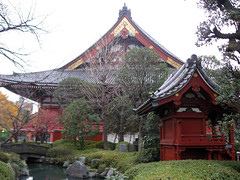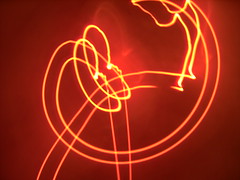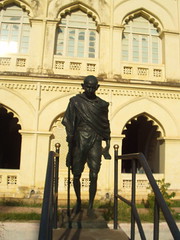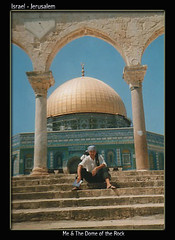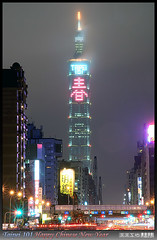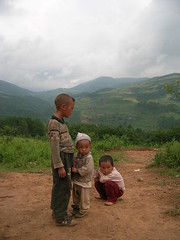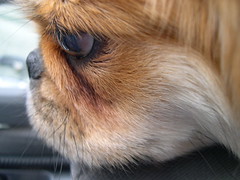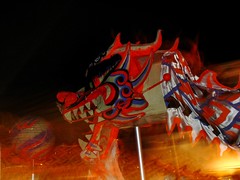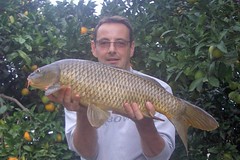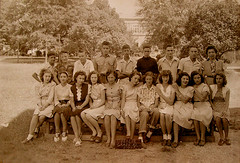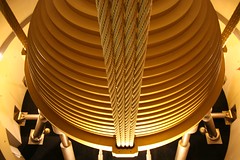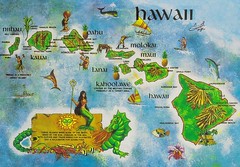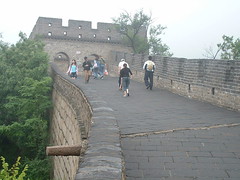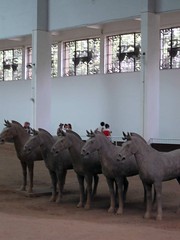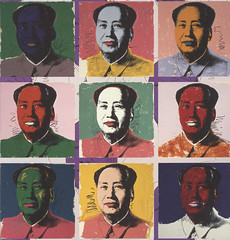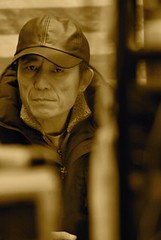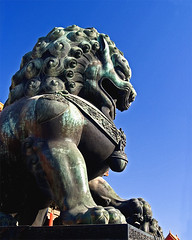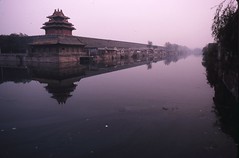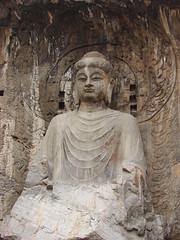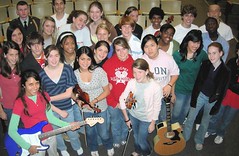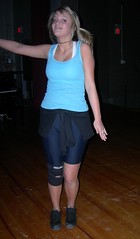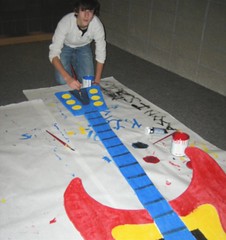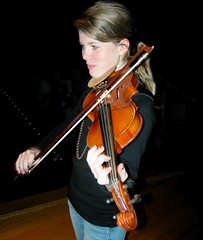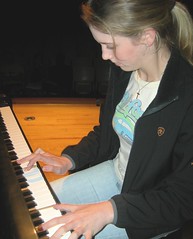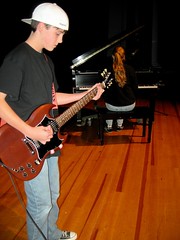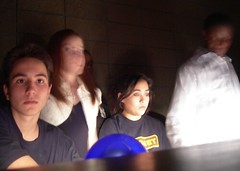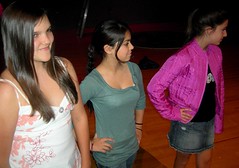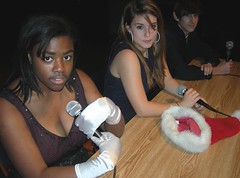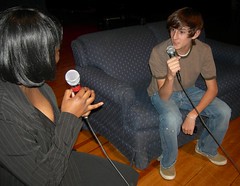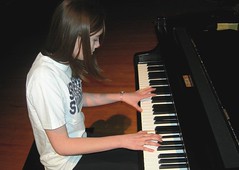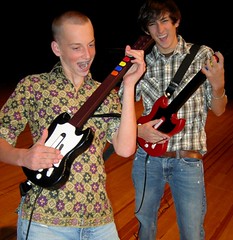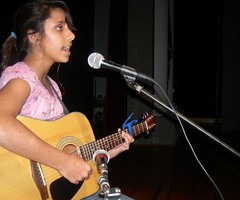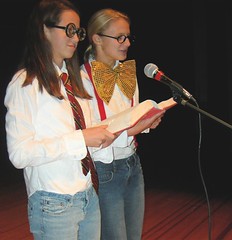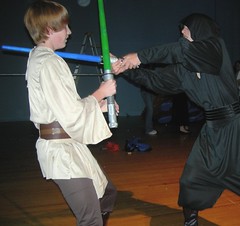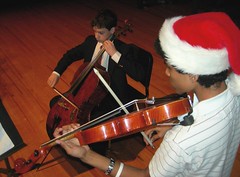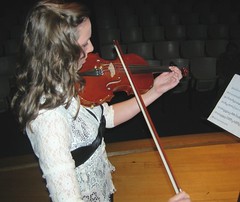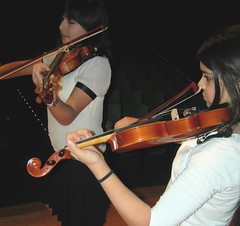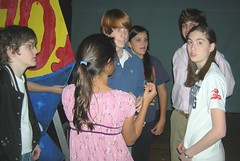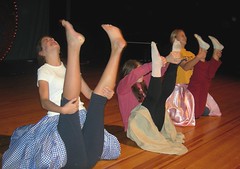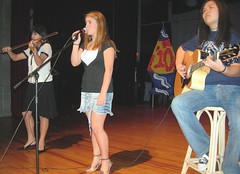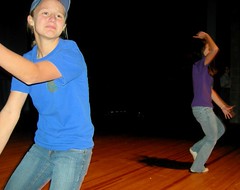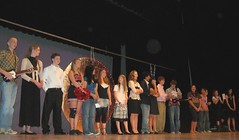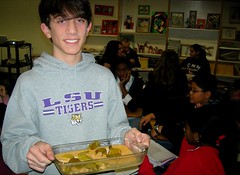Military doctrine / Think before you shoot
Dec 19th 2006 From The Economist print edition
A new field manual teaches American forces how to fight elusive insurgents
AMERICA is no stranger to “small wars”: those messy conflicts where the hard part is not to destroy the enemy but to identify him and where there are no front-lines or clear-cut victories. As its power expanded in the 19th century, America raided the Barbary coast, intervened in China, colonised the Philippines and carried out many landings in the Caribbean. But this long experience of imperial policing has been strangely forgotten. The triumph of the second world war, the ignominy of Vietnam and confrontation with the massed armies of the Soviet block in the cold war convinced America to turn away from small wars to concentrate on winning the big ones.
These days, however, American commanders are reaching for the history books as they discover that high-tech firepower is of little use—and can often be counter-productive—in the streets of Baghdad. Some have sought inspiration in classics such as T. E. Lawrence's “Seven Pillars of Wisdom”, published in 1922, or the Marine Corps' rediscovered “Small Wars Manual” of 1940. On December 15th they got some official help in the form of a new joint army and marines field manual.
“FM 3-24 Counterinsurgency” makes awkward reading for those trained in the notion of out-manoeuvring and annihilating an enemy force. Now American troops must be “ready to be greeted with either a handshake or a hand grenade” and must be “nation-builders as well as warriors”. Under the new doctrine, fighting insurgents involves “armed social work”. “Sometimes doing nothing is the best reaction,” says the manual. The best weapon is sometimes none at all. The prime objective is not to kill as many insurgents as possible but to maximise support from the local population. Above all, troops must adapt quickly.
Instead of isolating themselves in large camps and driving around in armoured vehicles, the manual advises American troops to live “close to the populace”, move on foot, sleep in villages and patrol by day and night. Each company should have a political as well as a “cultural” adviser. Platoons should assign their best soldiers to intelligence and surveillance, even at the cost of firepower. Forget the chain of command: decisions should be taken by consensus where possible.
Soldiering is only one strand. It must be entwined with others—including providing essential services, promoting good governance, building up local security forces and devising an information policy to counter insurgents' propaganda.
The 282-page manual reads at times like a litany of the things America has done wrong in Iraq. But those arguing for withdrawal will find little solace. Insurgencies, it says, “are protracted by nature”. America and its allies must show the “ability, stamina, and will to win”.
Moreover, counter-insurgency cannot be done on the cheap. It requires large amounts of manpower—some 20 to 25 members of security forces for every 1,000 civilians. The 483,000 combined coalition and Iraqi forces (of dubious quality and loyalty) fall well short of the 535,000 to 670,000 required to secure Iraq.
If American commanders' response to Vietnam was to foreswear nasty small wars, their reaction to the fiasco in Iraq seems so far to be quite different: to learn to fight them better. The new manual is a first step, but America's military culture may stand in need of deeper change. A start might be to rewrite the first words of its “warrior ethos”, whereby every soldier declares: “I stand ready to deploy, engage, and destroy the enemies of the United States of America.”
Sunday, December 31, 2006
Second semester overview: from the Land of the Rising Sun to the sunset of the Spanish Inquisition
Second semester in world geography -
Skills to be emphasized -
* Scientific method: as demonstrated in a brief but well-reasoned social studies fair-type project. Question / hypothesis / evidence gathering / conclusion / evaluation / synopsis.
* Essay guidelines: colorful opening, generalities & evidence,
documentation.
* Effective lighting & composition in photography.
* Effective lighting & audio in video production.
* Assembling a personal portfolio / resume.
* Analysis of issues as portrayed in editorial cartoons.
* Use of charts, diagrams, graphs in geographic communications.
* Analysis in migrations and demographic trends.
* Description & analysis in natural resources.
* Description in physical systems: rifts, biosphere, hydrosohere, lithosphere, earthquakes.
* Analysis of diplomacy and warfare in world affairs.
* Assessment & analysis of economic systems.
* Evaluation of environmental issues and solutions.
Units -
* Photography in the social sciences.
* Scientific method and social studies research.
* Japan: culture and historic impact. Technology and trends.
* Africa: resources & issues across the continent.
* West Africa and its influence on American culture.
* Greece: classical history and influences on the US.
* Russia: contemporary global impact and history.
* Germany: relationship with the US via history and technology.
* France: art, cuisine and contemporary role.
* L'Italia: the influence of the Roman Empire and Christian church.
* Britain: democracy, the press, language & the empire.
* Spain: the impact of the empire on global affairs.
Skills to be emphasized -
* Scientific method: as demonstrated in a brief but well-reasoned social studies fair-type project. Question / hypothesis / evidence gathering / conclusion / evaluation / synopsis.
* Essay guidelines: colorful opening, generalities & evidence,
documentation.
* Effective lighting & composition in photography.
* Effective lighting & audio in video production.
* Assembling a personal portfolio / resume.
* Analysis of issues as portrayed in editorial cartoons.
* Use of charts, diagrams, graphs in geographic communications.
* Analysis in migrations and demographic trends.
* Description & analysis in natural resources.
* Description in physical systems: rifts, biosphere, hydrosohere, lithosphere, earthquakes.
* Analysis of diplomacy and warfare in world affairs.
* Assessment & analysis of economic systems.
* Evaluation of environmental issues and solutions.
Units -
* Photography in the social sciences.
* Scientific method and social studies research.
* Japan: culture and historic impact. Technology and trends.
* Africa: resources & issues across the continent.
* West Africa and its influence on American culture.
* Greece: classical history and influences on the US.
* Russia: contemporary global impact and history.
* Germany: relationship with the US via history and technology.
* France: art, cuisine and contemporary role.
* L'Italia: the influence of the Roman Empire and Christian church.
* Britain: democracy, the press, language & the empire.
* Spain: the impact of the empire on global affairs.
Monday, December 18, 2006
Camera for Xmas?
Our first unit of the new semester will be Photography in the Social Studies. In it you will see the impact of photos on the social sciences (conservation, poverty, health, etc). You will learn to use photography as an academic skill (record keeping, in history, literature, etc).
It's a lifetime skill and you can show great improvement in a hurry.
***********
Tonight, Mon Dec 18, is the last point at which I'll accept independent work unless the situation is extreme.
Exams are going well. Have the print-out from the web site, a pencil and paper for the essay.
Good luck getting your sleep. And in slowing down as you work through each exam.
It's a lifetime skill and you can show great improvement in a hurry.
***********
Tonight, Mon Dec 18, is the last point at which I'll accept independent work unless the situation is extreme.
Exams are going well. Have the print-out from the web site, a pencil and paper for the essay.
Good luck getting your sleep. And in slowing down as you work through each exam.
Sunday, December 17, 2006
Sample test on the life of Gandhi
Gandhi and India
1. Gandhi’s first success in protest work took place in the nation of ____ _____.
2. One of Gandhi’s legal tacks was to assert that Indians were due rights since they were ____ subjects.
3. Gandhi’s strategy called for using the principles of the ________ religion.
4. He also knew that two institutions in British life would be helpful to his movement for fairness to Indians: the British ______ system, and the free ____ of England.
5. Gandhi was assassinated by a fanatic from the ____ religion. “Bapu” (Hindi nickname: “father”) was 78 years old.
6. One of his principal issues was increased tolerance between the primary religious sects of India: ___ and ___.
7. In 1919 a British general brought his troops to the site of a peaceful meeting in a Sikh temple courtyard. When the incident was over some 400 defenseless people were ____.
8. After 1920 Gandhi began a campaign against the British domination of the textiles sold in India. From that point he was usually photographed with a basic implement called a ____ ____.
9. In 1930 Gandhiji led a 240 mile march to the sea. He was protesting the British tax on the food-related substance: ____.
10. In the protests he led Gandhi emphasized a) creative violence b) non-violence.
11. Gandhi was born in Porbandar, by the shores of the ______ Sea.
12. During WWII, 1939 - 1945, Gandhi was sympathetic to British war needs and ceased his protest work. T / F
13. Gandhi did not want to see India separated in 1947. Nonetheless the vast nation was partitioned. Muslims were given the new nations of ______ and _____.
14. Few leaders have effectively reached out to a chaotic society like Gandhi did in the 1930’s and 40’s. When all of his appeals failed he touched the masses of India by undertaking a personal ____.
15. His principal journey outside of India in search of freedom for India was to a home rule conference in _______.
Answers:
1. South Africa 2. British 3. Christian 4. legal, speech 5. Hindu
6. Hindu, Muslim 7. murdered 8. spinning wheel 9. salt
10. b) non-violence 11. Arabian Sea 12. False
13. Pakistan, Bangladesh 14. fast 15. London, England
1. Gandhi’s first success in protest work took place in the nation of ____ _____.
2. One of Gandhi’s legal tacks was to assert that Indians were due rights since they were ____ subjects.
3. Gandhi’s strategy called for using the principles of the ________ religion.
4. He also knew that two institutions in British life would be helpful to his movement for fairness to Indians: the British ______ system, and the free ____ of England.
5. Gandhi was assassinated by a fanatic from the ____ religion. “Bapu” (Hindi nickname: “father”) was 78 years old.
6. One of his principal issues was increased tolerance between the primary religious sects of India: ___ and ___.
7. In 1919 a British general brought his troops to the site of a peaceful meeting in a Sikh temple courtyard. When the incident was over some 400 defenseless people were ____.
8. After 1920 Gandhi began a campaign against the British domination of the textiles sold in India. From that point he was usually photographed with a basic implement called a ____ ____.
9. In 1930 Gandhiji led a 240 mile march to the sea. He was protesting the British tax on the food-related substance: ____.
10. In the protests he led Gandhi emphasized a) creative violence b) non-violence.
11. Gandhi was born in Porbandar, by the shores of the ______ Sea.
12. During WWII, 1939 - 1945, Gandhi was sympathetic to British war needs and ceased his protest work. T / F
13. Gandhi did not want to see India separated in 1947. Nonetheless the vast nation was partitioned. Muslims were given the new nations of ______ and _____.
14. Few leaders have effectively reached out to a chaotic society like Gandhi did in the 1930’s and 40’s. When all of his appeals failed he touched the masses of India by undertaking a personal ____.
15. His principal journey outside of India in search of freedom for India was to a home rule conference in _______.
Answers:
1. South Africa 2. British 3. Christian 4. legal, speech 5. Hindu
6. Hindu, Muslim 7. murdered 8. spinning wheel 9. salt
10. b) non-violence 11. Arabian Sea 12. False
13. Pakistan, Bangladesh 14. fast 15. London, England
October test / Israel & Arabia with answers
I s r a e l & A r a b i a / T r u d e a u
1. In Jerusalem this landmark lies south of the Church of the Holy Sepulcher and the Dome of the Rock as well as between them. a) Western Wall b) Via Dolorosa c) Citadel d) Damascus Gate.
2. He is thought of as the man who bridges the monotheistic religions: a) Jesus of Nazareth b) Abraham c) Prophet Muhammad d) King David.
3. This man is believed to have ascended into heaven from Jerusalem. a) Jesus of Nazareth b) Abraham c) Prophet Muhammad d) King David.
4. Unlike many of the world’s notable cities, Jerusalem is not located on a river. Over the centuries traders have had to depend on the city’s harbors on the Mediterranean Sea. T / F
5. Jerusalem is a city in which people observe _ sabbaths. a) 2 b) 3 c) 4 d) 5.
6. This region has been visited by the Holy Family, Lawrence of Arabia, Moses and numerous bandits: a) Negev Desert b) West Bank c) Nafud Desert d) Sinai Peninsula.
7. Syrup-soaked Middle Eastern pastry that is made from paper-thin sheets of phyllo dough and chopped nuts. a) Baklava b) Pita c) Hummus d) Tzatziki.
8. In Lawrence of Arabia the character Col. Brighton states why he thinks Great Britain is a great nation, though small in land, population and resources. It was a) Navy b) high-quality guns
c) brain power d) discipline.
9. In the desert the nomads make villages in dry canyons surrounded by rock walls. These places are called a) oases b) wadis c) dunes d) aquifers.
10. A permissible Jewish occupation in a Christian city:
a) usury b) slave trading c) scapegoat d) debtors.
11. Which of these sites is not a source but considered a portal, or entryway, into a world of sites referring to a particular topic? a) Yahoo.com b) Infoplease.com c) CIA.gov
d) Answers.com.
12. An exodus is similar to emigration, which is the same as a) dispersal b) immigration c) retribution d) extrication.
13. The pre-1948 name for today’s Israel: a) Palestine b) Lebanon c) Zion d) Ottoman Empire.
14. In chronological order: a) Judaism, Islam, Christianity
b) Christianity, Islam, Judaism c) Islam, Christianity, Judaism
d) Judaism, Christianity, Islam.
15. The Islamic feast of Rosh Hashanah is known as their New Year, or "head of the year," according to Wikipedia.org. No work may be done on Rosh Hashanah. T / F
16. What language has Lawrence learned, in addition to his mother tongue and French? a) Greek b) Arabic c) Hebrew d) Egyptian.
17. In Arabia there is a conflict between the tribal Bedouin peoples and the Turks. Their empire, which includes Arabia, is called the __ Empire.
a) Prussian b) Turkic c) Ottoman d) Egyptian.
18. In 1915 the top British priority in the Mid East was protection of a waterway important to their shipping and movement of warships.
a) Suez Canal b) Red Sea c) Arabian Sea d) Persian Gulf.
19. In the early 1900’s the city at the center of Islamic art, business and scholarship was not Mecca, nor Cairo. It was the capital of Syria. a) Damascus b) Beirut c) Medina d) Tel Aviv.
20. In the early phase of the movie Lawrence of Arabia the hero, TE Lawrence, resides in 3 nations. a) England, Egypt, Saudi Arabia b) England, Syria, Saudi Arabia c) England, Saudi Arabia, Israel d) England, Saudi Arabia, Iraq.
Israel & Arabia test / Trudeau / Answeroonies
1. a Western Wall
2. b Abraham
3. c Prophet Muhammad
4. f
5. b 3
6. d Sinai
7. a Baklava
8. d discipline
9. d wadis
10. a usury
11. a Yahoo
12. a dispersal
13. a Palestine
14. d J, C, I
15. F
16. b Arabic
17. c Ottoman
18. a Suez canal
19. a Damascus
20. a E, E, SA
China review and Essay skills
China review / geography / Trudeau
1. Most populous Chinese city: a) Shanghai b) Hong Kong c) Beijing d) Xian.
2. China’s southernmost city: ) Shanghai b) Hong Kong c) Beijing d) Xian.
3. Once China’s capital was the city of Xian. Today its place has been taken by ) Shanghai b) Hong Kong c) Beijing d) Xian.
4. City that is the site of the Buried Army of Shi Hung Di: ) Shanghai b) Hong Kong c) Beijing d) Xian.
5. Known as the Huang river: a) Yellow b) Pearl c) Yangtze.
6. Known as the Chang river: a) Yellow b) Pearl c) Yangtze.
7. Not part of a peninsula: a) Korea b) Vietnam c) Taiwan d) Thailand.
8. The least-populated part of China: a) Tibet b) Mongolia c) East China Sea coast d) Yellow Sea region.
9. Not an ancient technological innovation of the Chinese: a) compass b) telescope c) paper d) gunpowder.
10. Multi-story tower: a) koi b) carp c) dalai lama d) pagoda.
11. The rate at which US students drop out of school is about 20%, says a schools policy institute. T / F
12. The world’s tallest building is the Taipei 101. It is in the earthquake-prone nation of a) China b) South Korea c) Malaysia d) Taiwan.
13. Differentiation between words in the Chinese language is based on a) vowels b) tones c) characters d) dialects.
14. The first emperor of China, Qin Shi Huang Di, opposed the teachings of a) Buddha b) Yin & yang c) Confucius
d) Dalai Lama.
15. Maui is south of Oahu. T / F
16. Pearl Harbor is on the island of a) Kaui b) Honolulu c) Maui d) Oahu.
17. Not an archipelago: a) Afghanistan
b) Japan c) Philippines d) Indonesia.
18. Island on which you will find 3 nations: a) Borneo b) Hainan c) Taiwan d) Indonesia.
19. The southern Chinese city of Guangzhou is almost exactly on the imaginary line known as the Tropic of Capricorn. T / F
20. Not a neighbor of China:
a) Kazakhstan b) Bangladesh c) Bhutan d) Laos.
21. The eastern regions of China are mountainous but the western regions lack mountains. T / F
22. Vietnam, Cambodia, Laos:
a) Southeast Asia b) Indonesia c) East Asia d) Central Asia.
23. The population of Hawaii is about 4 times larger than that of Louisiana (pre-Katrina). T / F
24. The Great Wall was an attempt to defend China from the people of
a) Mongolia b) Indochina c) Japan d) India.
25. 20th century political leader who brought communism to one billion people: a) Mao Zedong b) Ho Chi Minh
c) Qin Shi Huang Di d) Sergey Brin.
***********
Essay skills -
Generalities to be followed by a specific statement:
1. The Vietnam war was lengthy.
- For the US it lasted from 1954 to 1973.
2. The Vietnam war resulted in many deaths among the young US soldiers.
- Some 60,000 were killed.
3. The US was helped in the Vietnam struggle by several allies.
- Canadian and Australian troops fought alongside us.
4. Ho Chi Minh had support from other communist nations.
- Russia and China sent weapons and gave other aid to the North Vietnamese during the war.
5. In 1954 Vietnam became a divided nation.
- The communists controlled North Vietnam; South Vietnam remained democratic.
6.Some 5 presidents presided over US troops being sent to Vietnam.
- They were Truman, Eisenhower, Kennedy, Johnson and Nixon.
7. The Vietnam war became unpopular as the years went by.
- War protests peaked around 1968 with a demonstration in Washington, DC, that drew 250,000 marchers.
1. Most populous Chinese city: a) Shanghai b) Hong Kong c) Beijing d) Xian.
2. China’s southernmost city: ) Shanghai b) Hong Kong c) Beijing d) Xian.
3. Once China’s capital was the city of Xian. Today its place has been taken by ) Shanghai b) Hong Kong c) Beijing d) Xian.
4. City that is the site of the Buried Army of Shi Hung Di: ) Shanghai b) Hong Kong c) Beijing d) Xian.
5. Known as the Huang river: a) Yellow b) Pearl c) Yangtze.
6. Known as the Chang river: a) Yellow b) Pearl c) Yangtze.
7. Not part of a peninsula: a) Korea b) Vietnam c) Taiwan d) Thailand.
8. The least-populated part of China: a) Tibet b) Mongolia c) East China Sea coast d) Yellow Sea region.
9. Not an ancient technological innovation of the Chinese: a) compass b) telescope c) paper d) gunpowder.
10. Multi-story tower: a) koi b) carp c) dalai lama d) pagoda.
11. The rate at which US students drop out of school is about 20%, says a schools policy institute. T / F
12. The world’s tallest building is the Taipei 101. It is in the earthquake-prone nation of a) China b) South Korea c) Malaysia d) Taiwan.
13. Differentiation between words in the Chinese language is based on a) vowels b) tones c) characters d) dialects.
14. The first emperor of China, Qin Shi Huang Di, opposed the teachings of a) Buddha b) Yin & yang c) Confucius
d) Dalai Lama.
15. Maui is south of Oahu. T / F
16. Pearl Harbor is on the island of a) Kaui b) Honolulu c) Maui d) Oahu.
17. Not an archipelago: a) Afghanistan
b) Japan c) Philippines d) Indonesia.
18. Island on which you will find 3 nations: a) Borneo b) Hainan c) Taiwan d) Indonesia.
19. The southern Chinese city of Guangzhou is almost exactly on the imaginary line known as the Tropic of Capricorn. T / F
20. Not a neighbor of China:
a) Kazakhstan b) Bangladesh c) Bhutan d) Laos.
21. The eastern regions of China are mountainous but the western regions lack mountains. T / F
22. Vietnam, Cambodia, Laos:
a) Southeast Asia b) Indonesia c) East Asia d) Central Asia.
23. The population of Hawaii is about 4 times larger than that of Louisiana (pre-Katrina). T / F
24. The Great Wall was an attempt to defend China from the people of
a) Mongolia b) Indochina c) Japan d) India.
25. 20th century political leader who brought communism to one billion people: a) Mao Zedong b) Ho Chi Minh
c) Qin Shi Huang Di d) Sergey Brin.
***********
Essay skills -
Generalities to be followed by a specific statement:
1. The Vietnam war was lengthy.
- For the US it lasted from 1954 to 1973.
2. The Vietnam war resulted in many deaths among the young US soldiers.
- Some 60,000 were killed.
3. The US was helped in the Vietnam struggle by several allies.
- Canadian and Australian troops fought alongside us.
4. Ho Chi Minh had support from other communist nations.
- Russia and China sent weapons and gave other aid to the North Vietnamese during the war.
5. In 1954 Vietnam became a divided nation.
- The communists controlled North Vietnam; South Vietnam remained democratic.
6.Some 5 presidents presided over US troops being sent to Vietnam.
- They were Truman, Eisenhower, Kennedy, Johnson and Nixon.
7. The Vietnam war became unpopular as the years went by.
- War protests peaked around 1968 with a demonstration in Washington, DC, that drew 250,000 marchers.
Friday, December 15, 2006
Sem Exam: notes from Oct, Nov, Dec
Semester exam in geography -
- 100 multiple-choice questions beginning with notes in Oct and continuing through Dec.
- Open notes.
- Bring pencil (answers will be marked on Scantron sheets).
- Bring atlas and notes.
Also,
- a Brief Essay:
* Snappy title & explanatory subtitle.
* Colorful opening (description or quote).
* Documentation via "according to" near the end of the first paragraph.
* Original writing. No lengthy use of others' phrases.
* Generalities followed by specific examples.
Generality: US involvement in Vietnam continued over a long period.
Specific: US soldiers were there from 1954 to 1973.
- 100 multiple-choice questions beginning with notes in Oct and continuing through Dec.
- Open notes.
- Bring pencil (answers will be marked on Scantron sheets).
- Bring atlas and notes.
Also,
- a Brief Essay:
* Snappy title & explanatory subtitle.
* Colorful opening (description or quote).
* Documentation via "according to" near the end of the first paragraph.
* Original writing. No lengthy use of others' phrases.
* Generalities followed by specific examples.
Generality: US involvement in Vietnam continued over a long period.
Specific: US soldiers were there from 1954 to 1973.
Tuesday, December 12, 2006
The list of Chinese inventions is astounding to a Westerner
History of Chinese technology / Wikipedia.org
Among the scientific accomplishments of China were early seismological detectors,
matches,
paper,
dry docks,
sliding calipers,
the double-action piston pump,
cast iron,
the iron plough,
the multi-tube seed drill,
the wheelbarrow,
the suspension bridge,
the parachute,
natural gas as fuel,
the magnetic compass,
the raised-relief map,
the propeller,
the crossbow,
gunpowder and
printing.
Paper, printing, and gunpowder are celebrated in Chinese culture as the Four Great Inventions of ancient China.
Chinese astronomers were also among the first to record observations of a supernova.
One question that has been the subject of debate among historians has been why China did not develop a scientific revolution and why Chinese technology fell behind that of Europe. Many hypotheses have been proposed ranging from the cultural to the political and economic. Nathan Sivin has argued that China indeed had a scientific revolution in the 17th Century and that we are still far from understanding the scientific revolutions of the West and China in all their political, economic and social ramifications. John K. Fairbank argued that the Chinese political system was hostile to scientific progress.
More recent historians have questioned political and cultural explanations and have focused more on economic causes. Mark Elvin's high level equilibrium trap is one well-known example of this line of thought, as well as Kenneth Pomeranz' argument that resources from the New World were made crucial difference between European and Chinese development.
Chinese mathematics evolved independently from Greek mathematics and is therefore of great interest in the history of mathematics.
Chinese architecture project - apartments, farmers' house, Buddhist pagoda, nobleman's house
Students are constructing a Chinese community by assembling models of these basic housing types:
* apartment tower
* nobleman's traditional house
* farmer's thatched-roof house
* Buddhist pagoda
8 pts. when colored & assembled
The China map quiz was worth 13 pts (10 identifications plus 3 pts for borders) but students were able to add items so as to make up to 5 bonus pts.
* apartment tower
* nobleman's traditional house
* farmer's thatched-roof house
* Buddhist pagoda
8 pts. when colored & assembled
The China map quiz was worth 13 pts (10 identifications plus 3 pts for borders) but students were able to add items so as to make up to 5 bonus pts.
Monday, December 11, 2006
The Pekingese and the many breeds that originated in China
Here's my list of breeds that originated in China:
Sharpei
Chow
Lhasa
Pug
Pekingese
Can you add to the list?
Sharpei
Chow
Lhasa
Pug
Pekingese
Can you add to the list?
Second semester project: making a Chinese dragon for a big parade
When the Chinese New Year arrives in February, we will be ready with a Chinese dragon built in segments and ready for a campus parade. Planning is underway.
Spiritual head of Tibetan Buddhists, the Dalai Lama
The Dalai Lama is the guru of Tibetan Buddhists, but he is more: he travels the world speaking for peace and negotiation. He is like a Pope inasmuch as he uses his position to try to make men see a higher goal.
Because the Chinese have tried to squash Tibetan Buddhist culture, the Dalai Lama lives in exile. When he is not traveling, he lives in India.
Because the Chinese have tried to squash Tibetan Buddhist culture, the Dalai Lama lives in exile. When he is not traveling, he lives in India.
Aquaculture, another similarity between China and Louisiana
They grow carp and crayfish. We farm catfish, crawfish, bass and oysters.
Koi is what the Japanese call Carp. It is one of the world's great food fishes.
Koi is what the Japanese call Carp. It is one of the world's great food fishes.
School drop-outs: do we share the problem with China?
In the Zhang Yimou movie "Not One Less" we watch a 13 year-old substitute teacher battle the drop-out rate so she can get earn more pay. While the rural, impoverished school in the Chinese movie may seem to have little to do with our world, be assured that the drop-out rate in Louisiana - in Caddo Parish - is quite high. And school administrators are being rewarded for fighting the tendency of poor students to stop attending classes.
In general, the US drop-out rate seems to be about %30. It is 50% for students who are born to ethnic monority groups.
Why do states not clearly state their drop-out figures? It is embarassing. And the numbers show that it is not an easy problem to solve.
Here's some background from a public policy site:
States fudging high school dropout rates
While President Bush and the nation's governors want to reform America's high schools -- which have slipped to 17th place among developed nations in graduation rates -- unreliable information on dropouts is threatening to undermine those efforts, said Kate Haycock, director of the Education Trust, a nonprofit organization that works to increase academic achievement in schools.
"We've got to end this rampant dishonesty about graduation rates if we are going to prepare students for the challenges of college, work and life," Haycock said. Education Trust receives some of its funding from the The Pew Charitable Trusts, which also funds Stateline.org.
The report examines the 2002-2003 graduation-rate data reported by states to the federal government in January 2005. Three states -- Alabama, Louisiana and Massachusetts -- did not report any graduation rates. Officials in those states said they did not yet have data-collecting systems in place to calculate graduation rates.
The report found that most states exaggerated their graduation rates by ignoring students who dropped out of high school before their senior year. Nationally, states reported an average graduation rate of 83 percent, far higher than independent measures, which estimate that at least 30 percent of public high school students nationwide fail to graduate in four years.
The report commended only two states -- Alaska and Washington -- for reporting realistic graduation rates. Measuring the percent of freshman who finish high school in four years, Alaska and Washington reported gradation rates of 67 and 66 percent respectively.
Washington state Superintendent of Schools Terry Bergeson said parents and school officials were shocked to learn the severity of the state's dropout problem.
In general, the US drop-out rate seems to be about %30. It is 50% for students who are born to ethnic monority groups.
Why do states not clearly state their drop-out figures? It is embarassing. And the numbers show that it is not an easy problem to solve.
Here's some background from a public policy site:
States fudging high school dropout rates
While President Bush and the nation's governors want to reform America's high schools -- which have slipped to 17th place among developed nations in graduation rates -- unreliable information on dropouts is threatening to undermine those efforts, said Kate Haycock, director of the Education Trust, a nonprofit organization that works to increase academic achievement in schools.
"We've got to end this rampant dishonesty about graduation rates if we are going to prepare students for the challenges of college, work and life," Haycock said. Education Trust receives some of its funding from the The Pew Charitable Trusts, which also funds Stateline.org.
The report examines the 2002-2003 graduation-rate data reported by states to the federal government in January 2005. Three states -- Alabama, Louisiana and Massachusetts -- did not report any graduation rates. Officials in those states said they did not yet have data-collecting systems in place to calculate graduation rates.
The report found that most states exaggerated their graduation rates by ignoring students who dropped out of high school before their senior year. Nationally, states reported an average graduation rate of 83 percent, far higher than independent measures, which estimate that at least 30 percent of public high school students nationwide fail to graduate in four years.
The report commended only two states -- Alaska and Washington -- for reporting realistic graduation rates. Measuring the percent of freshman who finish high school in four years, Alaska and Washington reported gradation rates of 67 and 66 percent respectively.
Washington state Superintendent of Schools Terry Bergeson said parents and school officials were shocked to learn the severity of the state's dropout problem.
Friday, December 08, 2006
101 Tapei: the world's largest steel orb inside the tallest building
Mrs. Lisa (Lihui) Wu, Magnet parent, and Mrs. Hsu Lee Liu, both of Taiwan and, now, Shreveport, visited classes this week.
Among the topics we covered:
* Feng Shui (Literally, "wind" & "water"), the arrangement of the elements of your life, principally buildings and furniture, so that your life will be healthy and wealthy.
* Chinese numerals and the the 4 tones of the Taiwanese dialect.
* 101 Taipei, the world's tallest building. Built in earthquake-prone Taipei, the capital of Taiwan, it has a special steel ball housed near the top that balances the sway.
* Chop stick technique.
* Chinese cookies and dessert.
* Stir fried rice.
In my class notes:
* wok and quick stir fry.
* Szechwan & Hunan regions, where the cooking is often peppery.
* soybean, the perfect food.
Bureaucrats and bureaucracy: may be inflexible, obstructive ("never admit error," "chain of command") and prone to random bias. But also may be enlightened. Sketch: people behind large desks.
Repousse: working a pattern into malleable metal by tracing and chasing a design. An ancient art. See the Egyptians.
Among the topics we covered:
* Feng Shui (Literally, "wind" & "water"), the arrangement of the elements of your life, principally buildings and furniture, so that your life will be healthy and wealthy.
* Chinese numerals and the the 4 tones of the Taiwanese dialect.
* 101 Taipei, the world's tallest building. Built in earthquake-prone Taipei, the capital of Taiwan, it has a special steel ball housed near the top that balances the sway.
* Chop stick technique.
* Chinese cookies and dessert.
* Stir fried rice.
In my class notes:
* wok and quick stir fry.
* Szechwan & Hunan regions, where the cooking is often peppery.
* soybean, the perfect food.
Bureaucrats and bureaucracy: may be inflexible, obstructive ("never admit error," "chain of command") and prone to random bias. But also may be enlightened. Sketch: people behind large desks.
Repousse: working a pattern into malleable metal by tracing and chasing a design. An ancient art. See the Egyptians.
Thursday, December 07, 2006
Hawaii & Pearl Harbor: basic background
On Sun, Dec 7, 1941, the US lost some 15 ships and over 2000 sailors when a Japanese air attack hit the US Naval base at Pearl Harbor.
For the previous 10 years the Japanese had been building an empire in East Asia. They had taken over Indonesia, Indochina, including Vietnam, and part of China. The military government of Japan had convinced the emperor that buildling an empire was appropriate.
There were numerous indications that the Japanese might attack the US in the Pacific.
************
Infoplease.com says, " First settled by Polynesians sailing from other Pacific islands between A.D. 300 and 600, Hawaii was visited in 1778 by British captain James Cook, who called the group the Sandwich Islands.
Hawaii was a native kingdom throughout most of the 19th century, when the expansion of the sugar industry (pineapple came after 1898) meant increasing U.S. business and political involvement. In 1893, Queen Liliuokalani was deposed, and a year later the Republic of Hawaii was established with Sanford B. Dole as president. Following annexation (1898), Hawaii became a U.S. territory in 1900."
Hawaiian map identifications -
1. Pearl Harbor
2. Honolulu
3. Oahu Island
4. Maui Island
5. Hawaii Island
6. Mauna Loa & Mauna Kea Mtns.
Population about 1.2 M.
Says Wikipedia.org, "Hawaii may be an especially healthy place to live. Hawaiians born in the year 2000 can expect to live 79.8 years (77.1 years if male, 82.5 if female), longer than the residents of any other state.[12] Mississippi came in 50th, living 73.6 years (70.4 male and 76.7 female), but the District of Columbia was dead last, living 72.6 years (68.5 male and 76.1 female)."
For the previous 10 years the Japanese had been building an empire in East Asia. They had taken over Indonesia, Indochina, including Vietnam, and part of China. The military government of Japan had convinced the emperor that buildling an empire was appropriate.
There were numerous indications that the Japanese might attack the US in the Pacific.
************
Infoplease.com says, " First settled by Polynesians sailing from other Pacific islands between A.D. 300 and 600, Hawaii was visited in 1778 by British captain James Cook, who called the group the Sandwich Islands.
Hawaii was a native kingdom throughout most of the 19th century, when the expansion of the sugar industry (pineapple came after 1898) meant increasing U.S. business and political involvement. In 1893, Queen Liliuokalani was deposed, and a year later the Republic of Hawaii was established with Sanford B. Dole as president. Following annexation (1898), Hawaii became a U.S. territory in 1900."
Hawaiian map identifications -
1. Pearl Harbor
2. Honolulu
3. Oahu Island
4. Maui Island
5. Hawaii Island
6. Mauna Loa & Mauna Kea Mtns.
Population about 1.2 M.
Says Wikipedia.org, "Hawaii may be an especially healthy place to live. Hawaiians born in the year 2000 can expect to live 79.8 years (77.1 years if male, 82.5 if female), longer than the residents of any other state.[12] Mississippi came in 50th, living 73.6 years (70.4 male and 76.7 female), but the District of Columbia was dead last, living 72.6 years (68.5 male and 76.1 female)."
Wednesday, December 06, 2006
10,000 watch towers, 4,000 miles: the Great Wall
The Great Wall of China ( Wànlǐ Chángchéng; literally "The long wall of 10,000 Li (里)¹") is a Chinese fortification built from the 5th century BC until the beginning of the 17th century, in order to protect the various dynasties from raids by Hunnic, Mongol, Turkic, and other nomadic tribes coming from areas in modern-day Mongolia and Manchuria.
Several walls, also referred to as the Great Wall of China, were built since the 5th century BC, the most famous being the one built between 220 BC and 200 BC by the first Emperor of China, Qin Shi Huang.
- The Great Wall is the world's largest man-made structure.
- 6,352 km (3,948 miles)
- Along most of its arc, it roughly delineates the border between North China and Inner Mongolia.
- 10,000 watch towers (which were used to store weapons, house troops, and send smoke signals),
- each tower has unique and restricted stairways and entries to confuse attackers.
Seen from outer space?
In fact, the Great Wall is only a few meters wide - similar in size to highways and airport runways - and is about the same color as the soil surrounding it. It cannot be seen by the unaided eye from the distance of the moon, much less from Mars. If the Great Wall were visible from the moon, it would be easy to see from near-Earth orbit, but from near-Earth orbit it is barely visible, and only under nearly perfect conditions; it is no more conspicuous than many other manmade objects.
- Communication between the army units along the length of the Great Wall, including the ability to call reinforcements and warn garrisons of enemy movements, was of high importance.
- Signal towers were built upon hill tops or other high points along the wall for their visibility.
8000 life-size figures in the Terra Cotta Army of Qin Shi Huang Di
The terracotta figures buried with the first Emperor of Qin (Qin Shi Huang) in 210-209 BC were to protect the Emperor in the afterlife, says Wikipedia.org.
- 8,099 life-size terra cotta figures of warriors and horses.
- Located near the Mausoleum of the First Qin Emperor.
- The Terracotta Army was discovered in March 1974.
- Mount Lishan is the name of the man-made necropolis of the First Emperor of the Qin Dynasty; [Qin Shi Huang].
- Construction of this mausoleum began in 246 BC and is believed to have taken 700,000 workers and craftsmen 38 years to complete.
- According to the Grand Historian Sima Qian, the First Emperor was buried alongside great amounts of treasure and objects of craftsmanship, as well as a scale replica of the universe complete with gemmed ceilings representing the cosmos, and flowing mercury representing the great earthly bodies of water. Pearls were also placed on the ceilings in the tomb to represent the stars and planets, etc.
In the army:
- infantry
- archers
- officers
- crouching or standing pose.
- real weapons such as bronze spears, halberds or swords, or wooden crossbows with bronze fittings.
Excavation at the site has shown a fire burned the wooden structures once housing the Terracotta Army. Such a fire is described by Sima Qian as part of the consequences of the raiding General Xiang Yu less than five years after the death of the First Emperor. It is said that the effects of General Xiang’s army included looting of the tomb and structures holding the Terracotta Army, as well as setting fire to the necropolis and starting a blaze that lasted for three months. Despite this fire, however, much of the remains of the Terracotta Army still survive in various stages of preservation, surrounded by remnants of the burnt wooden structures
- 8,099 life-size terra cotta figures of warriors and horses.
- Located near the Mausoleum of the First Qin Emperor.
- The Terracotta Army was discovered in March 1974.
- Mount Lishan is the name of the man-made necropolis of the First Emperor of the Qin Dynasty; [Qin Shi Huang].
- Construction of this mausoleum began in 246 BC and is believed to have taken 700,000 workers and craftsmen 38 years to complete.
- According to the Grand Historian Sima Qian, the First Emperor was buried alongside great amounts of treasure and objects of craftsmanship, as well as a scale replica of the universe complete with gemmed ceilings representing the cosmos, and flowing mercury representing the great earthly bodies of water. Pearls were also placed on the ceilings in the tomb to represent the stars and planets, etc.
In the army:
- infantry
- archers
- officers
- crouching or standing pose.
- real weapons such as bronze spears, halberds or swords, or wooden crossbows with bronze fittings.
Excavation at the site has shown a fire burned the wooden structures once housing the Terracotta Army. Such a fire is described by Sima Qian as part of the consequences of the raiding General Xiang Yu less than five years after the death of the First Emperor. It is said that the effects of General Xiang’s army included looting of the tomb and structures holding the Terracotta Army, as well as setting fire to the necropolis and starting a blaze that lasted for three months. Despite this fire, however, much of the remains of the Terracotta Army still survive in various stages of preservation, surrounded by remnants of the burnt wooden structures
Tuesday, December 05, 2006
Mao Zedong, communist dictator of China from 1949 to 1976
Chairman Mao was one of the most powerful men of the 20th century by virtue of leading the one billion citizens of China into a communist state.
Sadly, Mao's control led to farm policies that produced famine. In re-arranging the crop plan and the structure of farms he plunged the nation into chaos. Starvation resulted. But the outside knew nothing of that holocaust because of the communist control of news and the demographics of China. The truth was hidden behind a "bamboo curtain" of communist information control.
How do Americans tell the difference between Chinese and Japanese cultures?
One point is that the Chinese had a high civilization that was absorbed by the Koreans and, in turn, assimilated by the Japanese.
Map study:
Yangtze River flows into the East China Sea near Shanghai.
Yellow River flows into the Yellow Sea, which is near Korea.
The Great Wall more or less parallels the Yellow River - above Beijing.
The Yellow and Yangtze valleys are Cradles of Civilization and among the world's most densely-populated regions.
Flash drives:
please make sure your name is on something that's in the storage. Flash drives being forgotten in library computers would be returned quickly if student names were on some document inside.
Comapring European and Chinese astrology: what's more appealing than the Year of the Rat?
Sadly, Mao's control led to farm policies that produced famine. In re-arranging the crop plan and the structure of farms he plunged the nation into chaos. Starvation resulted. But the outside knew nothing of that holocaust because of the communist control of news and the demographics of China. The truth was hidden behind a "bamboo curtain" of communist information control.
How do Americans tell the difference between Chinese and Japanese cultures?
One point is that the Chinese had a high civilization that was absorbed by the Koreans and, in turn, assimilated by the Japanese.
Map study:
Yangtze River flows into the East China Sea near Shanghai.
Yellow River flows into the Yellow Sea, which is near Korea.
The Great Wall more or less parallels the Yellow River - above Beijing.
The Yellow and Yangtze valleys are Cradles of Civilization and among the world's most densely-populated regions.
Flash drives:
please make sure your name is on something that's in the storage. Flash drives being forgotten in library computers would be returned quickly if student names were on some document inside.
Comapring European and Chinese astrology: what's more appealing than the Year of the Rat?
House of Flying Daggers was a pop martial arts movie by Zhang Yimou of Not One Less
Here's a Yimou bio from the Sony.com site:
Born in Xian, China, in 1950, Zhang Yimou was in secondary school when the Cultural Revolution erupted in 1966. His studies were suspended and he was sent to work in the countryside in 1968, first on farms in Shanxi Province for three years, and from 1971 to 1978 as a laborer in a spinning mill. Interested in art and photography from an early age, Zhang pursued a hobby as a still photographer despite the scarcity of books and materials or the chance for his work to be published.
When the Beijing Film Academy held a nation-wide examination in 1978, Zhang enrolled and passed with high marks but was rejected because at age 27, he was five years beyond the accepted age limit. After two unsuccessful trips to Beijing to repeal the decision, he wrote directly to the Director of the Ministry of Culture, pleading his case on the grounds that he had wasted ten years because of the Cultural Revolution. Two months later, he was accepted to study in the Film Academy’s Department of Cinematography.
After graduating in 1982, he was assigned to work in the Guangxi Film Studio. In 1985, he moved to the Xian Film Studio and worked as a cinematographer.
Zhang made his directorial debut in 1988 with RED SORGHUM, starring Gong Li in her first film role. The film won the Golden Bear Award for Best Picture at the 1989 Berlin Film Festival. He went on to direct several more films with Gong Li including JU DOU (1990), which was nominated for an Oscar in 1991; RAISE THE RED LANTERN (1991), which was awarded the Silver Lion at the Venice Film Festival and was also nominated for an Academy Award; THE STORY OF QIU JU (1992), which won the Golden Lion at the 1992 Venice Film Festival; TO LIVE (1994) which won the Grand Jury Prize and Best Actor Award at the Cannes Film Festival; and SHANGHAI TRIAD, which was an Official Selection in Cannes in 1995.
In 1997, he directed the Puccini opera TURANDOT in Florence, Italy, with Zubin Mehta serving as conductor. In 1998, he and Mehta once again collaborated on a re-staging of the opera in Beijing’s Forbidden City. Since then has has made the mass-market movies Heros (02) and House of Flying Daggers (04).
Born in Xian, China, in 1950, Zhang Yimou was in secondary school when the Cultural Revolution erupted in 1966. His studies were suspended and he was sent to work in the countryside in 1968, first on farms in Shanxi Province for three years, and from 1971 to 1978 as a laborer in a spinning mill. Interested in art and photography from an early age, Zhang pursued a hobby as a still photographer despite the scarcity of books and materials or the chance for his work to be published.
When the Beijing Film Academy held a nation-wide examination in 1978, Zhang enrolled and passed with high marks but was rejected because at age 27, he was five years beyond the accepted age limit. After two unsuccessful trips to Beijing to repeal the decision, he wrote directly to the Director of the Ministry of Culture, pleading his case on the grounds that he had wasted ten years because of the Cultural Revolution. Two months later, he was accepted to study in the Film Academy’s Department of Cinematography.
After graduating in 1982, he was assigned to work in the Guangxi Film Studio. In 1985, he moved to the Xian Film Studio and worked as a cinematographer.
Zhang made his directorial debut in 1988 with RED SORGHUM, starring Gong Li in her first film role. The film won the Golden Bear Award for Best Picture at the 1989 Berlin Film Festival. He went on to direct several more films with Gong Li including JU DOU (1990), which was nominated for an Oscar in 1991; RAISE THE RED LANTERN (1991), which was awarded the Silver Lion at the Venice Film Festival and was also nominated for an Academy Award; THE STORY OF QIU JU (1992), which won the Golden Lion at the 1992 Venice Film Festival; TO LIVE (1994) which won the Grand Jury Prize and Best Actor Award at the Cannes Film Festival; and SHANGHAI TRIAD, which was an Official Selection in Cannes in 1995.
In 1997, he directed the Puccini opera TURANDOT in Florence, Italy, with Zubin Mehta serving as conductor. In 1998, he and Mehta once again collaborated on a re-staging of the opera in Beijing’s Forbidden City. Since then has has made the mass-market movies Heros (02) and House of Flying Daggers (04).
Watching a modern story of China in Mandarin Chinese: "Not One Less"
Not One Less is a Sony movie by esteemed director Zhang Yimou.
Movie vocab and characters to be able to identify:
Teacher Gao
Mandarin Chinese
13 year-old sub, Wei Minzhi, has not attended secondary school.
drop-out problem
Mayor
Zhang Huike, the boy.
yuan
Movie vocab and characters to be able to identify:
Teacher Gao
Mandarin Chinese
13 year-old sub, Wei Minzhi, has not attended secondary school.
drop-out problem
Mayor
Zhang Huike, the boy.
yuan
Semester exam: 100 mult-choice questions answered on Scantron sheets, open notes
The semester exam will follow the pattern of the weekly work of this class:
Multiple choice questions, emphasis on info management skills via Open notes format.
There will be 100 questions. Pencil mandatory: students will pencil in a mark for each answer on a Scantron sheet.
Some 70 questions will be drawn from the prior tests as found on the web site. Most of the answers are posted - not necessarily on the same page as the quiz. I will, indeed, post the remaining answers by this weekend.
The final 30 questions will be on our final units as seen on the web site:
Vietnam
Wash, DC
coffee
China
"Not One Less"
Independent work will, as usual, be limited to one submission per week. See new topics below or submit your own topic for my approval.
Note on the illustration:
This bronze lionesse ( or "Fu Dog" ) guards the entrance to the throne room of the Forbidden City in Beijing. Fu Dogs always come in pairs. They are mythical creatures with horns on the head of a lion, scales upon the body of a deer, and a tail consisting of little curls.
Multiple choice questions, emphasis on info management skills via Open notes format.
There will be 100 questions. Pencil mandatory: students will pencil in a mark for each answer on a Scantron sheet.
Some 70 questions will be drawn from the prior tests as found on the web site. Most of the answers are posted - not necessarily on the same page as the quiz. I will, indeed, post the remaining answers by this weekend.
The final 30 questions will be on our final units as seen on the web site:
Vietnam
Wash, DC
coffee
China
"Not One Less"
Independent work will, as usual, be limited to one submission per week. See new topics below or submit your own topic for my approval.
Note on the illustration:
This bronze lionesse ( or "Fu Dog" ) guards the entrance to the throne room of the Forbidden City in Beijing. Fu Dogs always come in pairs. They are mythical creatures with horns on the head of a lion, scales upon the body of a deer, and a tail consisting of little curls.
Monday, December 04, 2006
Ni hau! That's the world's most widely spoken form of "Hello"
More people speak Mandarin Chinese than any other language, says About.com. And today the world is learning Mandarin to enhance their chances of doing business with the awesome Asians.
Chinese is a tone-based language. An example: the difference between the words and pronunciations of the numerals 4 and 6 are minuscule, says student Lily Wu.
Mandarin (in English the word implies high-born or high in quality) is the northern and the official language. There is also Cantonese Chinese, mostly spoken in the south. And there are many dialects.
Great cities of the People's Republic of China:
Beijing (Peking)
Shanghai (the most populous at 17 M)
Hong Kong (the richest city)
Neighbors:
Japan
Taiwan (the Republic of China)
Vietnam
India
China
Mongolia
Russia
- There is a considerable contrast between the European dragon and the Chinese dragon.
- Chinese people are top performers in both business and the arts. They think of themselves as the world's greatest culture. They're as ethnocentric as Americans.
Some 15 years ago the communist government limited their tight control of the economy. With a capitalistic freedom the Chinese have been accelerating their economy.
The WalMart business model has hastened the loss of manufacturing jobs from the US to China, I'd say.
The US has developed a Service economy, focusing on:
insurance
banking
education
medical
entertainment
law
high-tech business, as in eBay and Google.
The US Working Class timeline shows progression from a Chinese-like no-rights worker to one protected and enriched by the union system. Today the salaries and benefits demanded by unions have priced US workers out of general competition.
Chinese is a tone-based language. An example: the difference between the words and pronunciations of the numerals 4 and 6 are minuscule, says student Lily Wu.
Mandarin (in English the word implies high-born or high in quality) is the northern and the official language. There is also Cantonese Chinese, mostly spoken in the south. And there are many dialects.
Great cities of the People's Republic of China:
Beijing (Peking)
Shanghai (the most populous at 17 M)
Hong Kong (the richest city)
Neighbors:
Japan
Taiwan (the Republic of China)
Vietnam
India
China
Mongolia
Russia
- There is a considerable contrast between the European dragon and the Chinese dragon.
- Chinese people are top performers in both business and the arts. They think of themselves as the world's greatest culture. They're as ethnocentric as Americans.
Some 15 years ago the communist government limited their tight control of the economy. With a capitalistic freedom the Chinese have been accelerating their economy.
The WalMart business model has hastened the loss of manufacturing jobs from the US to China, I'd say.
The US has developed a Service economy, focusing on:
insurance
banking
education
medical
entertainment
law
high-tech business, as in eBay and Google.
The US Working Class timeline shows progression from a Chinese-like no-rights worker to one protected and enriched by the union system. Today the salaries and benefits demanded by unions have priced US workers out of general competition.
Sunday, December 03, 2006
Why study China: WalMart, US Army, Guitars, Outsourcing, etc.
Our Giant Girlfriend, China
The new vs. the old China via the classic movie: "Not One Less"
- Ancient China: Emperor Shi Huang Di and the Great Wall.
- The Imperial City / Forbidden City.
- History of technology and the Chinese.
- Chinese art and cultural influence.
- Why China has suffered decades of poverty.
- Mao Zedong and the Communist era.
- How China has accomplished its Great Leap Forward.
- US-Chinese relations.
- Shanghai and Hong Kong, Chinese dragons.
- Taiwan, the Republic of China.
Independent comparisons -
1. Shanghai & Hong Kong
2. Shi Huang Di and Louis XIV
3. Mao Zedong and Lenin
4. Chinese dog breeds vs. European breeds
5. Chinese printing press and Johann Gutenberg.
6. Gunpowder & ancient rocketry and the modern rocket.
Brief unit on the basics of Washington DC
Know the basics of Washington, DC, for Thurs, please:
1. Watergate complex
2. Potomac River
3. Pentagon
4. Lincoln Memorial
5. Washington Monument
6. White House, 1600 Pennsylvania Ave
7. National mall
8. Air & Space Museum of Smithsonian Institution
9. US Capitol
10. Supreme Court Bldg.
11. Library of Congress
12. District of Columbia
13. Virginia
14. Maryland
15. Chesapeake Bay
16. Atlantic Ocean
1. Watergate complex
2. Potomac River
3. Pentagon
4. Lincoln Memorial
5. Washington Monument
6. White House, 1600 Pennsylvania Ave
7. National mall
8. Air & Space Museum of Smithsonian Institution
9. US Capitol
10. Supreme Court Bldg.
11. Library of Congress
12. District of Columbia
13. Virginia
14. Maryland
15. Chesapeake Bay
16. Atlantic Ocean
Saturday, December 02, 2006
Objective accomplished: Class of 2010 Talent Show 06
They made money for the class fund, made new friends, developed their skills, tried out new roles, worked at problem solving and human relations, learned about timing and responsibility and, in the process, produced a successful stage show. We are discussing the 40-odd students who spent a week (many of them spent much more time) producing the freshman extravaganza called Talent Show 06.
Producers: Diana Hock and Megan Shay.
Tech crew: Mac Orchard, Eric Coleman, Matt McHugh, Lauren Monroe, Andrew Delo, Phillipe Dentino.
Set design & Art: Mason Nabors, Michael Dai.
Production & acting: Maggie Caruthers, Meredith Cupp, Mason Nabors, Kaylah Williams, Elizabeth Burford, Alyssa Coggins, Andrew Delo, Eric Coleman.
Performers: Susan Beresko, Rachel Young, Claire Crosby, Anthony Fabio, Katy Li, Michelle Khare, Caroline Germany, Doug Pierce, Brooke Hightower, Diana Hock, Kaitlin Williams, Anvesh Kompelli, Philippe Dentino, Megan Sahy, Hali Kha, John Henry Crawford.
Pony Express JV Danceline: Brooke Hightower, Mattie Lewis, Shaneau Richardson, Devin Sibley, Alexis Stennis, Chelsea Fields, Leslie Justice.
Sponsors: Robert Trudeau, Paul Flowers, Pamela Anderson, Amanda Hock, Morgan Franklin.
Judges: Jodie Glorioso, Dan Anderson.
Student judges: Dante, Maysa & Cherish.
Producers: Diana Hock and Megan Shay.
Tech crew: Mac Orchard, Eric Coleman, Matt McHugh, Lauren Monroe, Andrew Delo, Phillipe Dentino.
Set design & Art: Mason Nabors, Michael Dai.
Production & acting: Maggie Caruthers, Meredith Cupp, Mason Nabors, Kaylah Williams, Elizabeth Burford, Alyssa Coggins, Andrew Delo, Eric Coleman.
Performers: Susan Beresko, Rachel Young, Claire Crosby, Anthony Fabio, Katy Li, Michelle Khare, Caroline Germany, Doug Pierce, Brooke Hightower, Diana Hock, Kaitlin Williams, Anvesh Kompelli, Philippe Dentino, Megan Sahy, Hali Kha, John Henry Crawford.
Pony Express JV Danceline: Brooke Hightower, Mattie Lewis, Shaneau Richardson, Devin Sibley, Alexis Stennis, Chelsea Fields, Leslie Justice.
Sponsors: Robert Trudeau, Paul Flowers, Pamela Anderson, Amanda Hock, Morgan Franklin.
Judges: Jodie Glorioso, Dan Anderson.
Student judges: Dante, Maysa & Cherish.
Thanks to veryone who attended and worked on the First-year-produced Talent Show 06
Talent Show 06, the Class of 2010, was quite a success even if I was worried about the transitions and equipment until the last minute.
Tyler Snelling: Thai curry chicken
Terrific gift for geogra[hy class from Tyler and his mom, Charla Snelling: Red Curry Chicken and Jackfruit pudding.
Merci!
Merci!
Subscribe to:
Posts (Atom)

